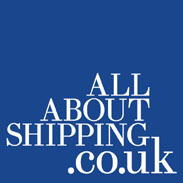
ICAEW, the Capital Link’s Forum venue
This 7th Shipping, Marine Services & Offshore Capital Link Forum in the Square Mile’s One Moorgate Place, will be remembered for ever not only because it surpassed any previous attendance record – something in the tune of 500+, not because more or less the various markets were covered – save the reefer ones, but because what was discussed, debated and expressed by the participants will be appropriately used one day as a counter in case their prognosis, particularly that of the speakers and debaters fails to match the future market projections… Over the last fifteen years a lot has been said and debated, and over the last six with this “unique” shipping crisis, everybody says his long and sort to the detriment of the shipowners, banks, and investors. Time will tell though, as in life, we ought to reconsider things and the think-twice issue gets its proper meaning, alike the one Bob Dylan gave us with his song, on another way around: “Don’t think Twice, it’s All Right” – you dead well know what I mean. Being worse than Aristotle and practicing to the utmost his constructive criticism, I have been very sceptical and tough from what I hear, read and judge on what the various experts say in our shipping field… You know their results and you can’t compare us no way near, as ours, with all due respect, speak for themselves! John Faraclas was there fully… armed with his mighty pen and camera…:

Nicolas Bornozis introducing the event and welcoming speakers and delegates
All in all a very important forum given what happens right now around the globe and pleased to see the effective way by which Nicolas Bornozis elevated this seven year old event and this particular one with the partnership of RS Platou Markets and the long standing cooperation with the London Stock Exchange in providing investors in the UK and Europe with a comprehensive review and current outlook of the various shipping markets, marine services and offshore markets, as well as an update on the other issues of critical importance to the industry.
Punctuality in the maritime world is of paramount importance and this forum begun its deliberations on time with Nicolas Bornozis introducing the event and warmly welcoming the hundreds of faithful; a very ship-shape kick-start!
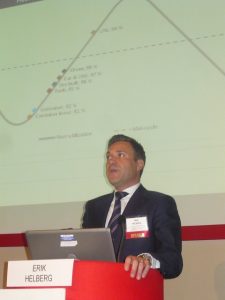
Erik Helberg
Erik Helberg, RS Platou’s CEO continued with the welcoming remarks and his substantial slides on the Marine Services Sector and in particular with an excellent one on: “Where are we now in the cycle”, specifically for the wet sector, as well with one on the “High willingness to pay up for the tanker freight”, VLCC rates per barrel vs. oil price. He mentioned and explained the issue of diminishing supply growth helping recovery take hold. A good point on the zero supply growth since April in the tanker markets, while freight rates have recovered. The Winter market always tends to hold promise, but climate changes are climate changes… He compared the current oil price, as the tanker rates are ridiculously low at the moment, a well construed point. Investors should hold their nerve and anticipate this recovery. A simple and to the point opening preparing for a great debate.
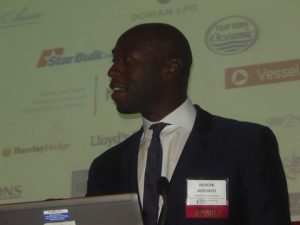
Ibukun Adebayo
Ibikun Adebayo, deputising LSE’s John V. Millar, took the podium for the Opening Remarks.
He said – in exactly seven minutes: “London is in the heart of two truly global industries; shipping and finance, since the 1770ies and their coffee houses. The Baltic Exchange and Lloyd’s of London are two other historic exchanges. London continues to remain at the centre of maritime commerce and finance to this day. Advisory expertise and reach of London is second to none. Over 30 international law firms advise on shipping law in London. About 20 shipping and other related companies with a public listing on the LSE. IPO window for shipping in London has reopened with US$1.1bn raised in last season. World’s largest pool of assets in London, with over US$2tn managed from a variety of institutions based here and overseas”; he was warmly applauded.

Peter Ashworth
Peter Ashworth from Charles Stanley Securities, an equity analyst continued on the Marine Services with a well prepared overview; he said:
“Marine Services (MS) is a sector that doesn’t demonstrate the same volatility as the shipping sector. MS covers a broad range of services to a diverse customer base:
Commercial (such as shipbuilding, repair and marine equipment)
Offshore industries, covering offshore energy
Offshore wind, where it’s forecast to see investment of £75bn by 2020 and has a leading global position.
Naval – stable outlook for UK defence business and the state of the order book looks robust.
Marine business services – legal, insurance, financials and shipbroking.
We are seeing a recovery in seaborne trade and the projections speak of c.5%pa growth in the coming years.
However, the sector is not immune to the issues that face the shipping sector in general.
The fact that it’s a global market appeals to investors across the world.
There are similarities with the Oil Service & Equipment sector and is sensitive to the oil price.
The sector tends to enjoy good visibility of their companies’ order books, providing comfort to investors.
Case study – James Fisher & Sons offers services to marine , oil & gas and other high assurance industries worldwide. Services include STS transfers, commercial diving, inspection and monitoring, mooring and fendering etc.
Price – £13.40
Market cap – £671m
EPS (FY1) of 73p
PE (FY1) of 18.3x and a dividend yield of 1.6%
Divex, Subsea Vision, Tess Consult and a Swedish company are recent bolt-on acquisitions, using available cash on the balance sheet.”
“MS offers exposure to wider shipping market
It is service driven rather than asset driven
Regulatory driven
A number of key drivers”.
That was yet another interesting warm-up bringing-in the guru of the markets…
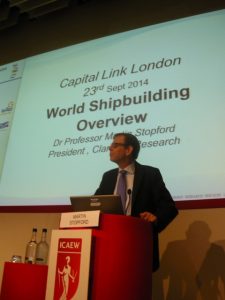
Dr. Professor Martin Stopford
Dr. Professor Martin Stopford, President from Clarkson’s Research Services presentation was titled: “World Shipbuilding Overview”. After a bit of a …curse striking at Martin, due to some technical hiccups with the screen, he got in his usual guru mood and explained with very convincing slides, using some extra time – he deserved it anyway:
“Recession in the tanker markets is still continuing. During the 1990ies recession, the earnings per day were around US$12, 000/day. This time around, we have a different regime and financial foreclosure is not as prevalent. We have a backlog of ships but now the demand is growing at about the same rate as supply.
Shadow surplus – tonnage in excess of the dwt of ships needed to carry trade at full speed – is higher today than what it was during the late 70ies and 80ies. But then, you had many more tankers and bulkers laid up.
World economy remains sluggish and patchy across the world. China is not the economy it once was and are trying to cope with their debt mountain. Other Asia is disappointing too. India is not going to be another China, despite Mr Modi’s efforts.
Greece remains the no.1 investor in shipping with US$7.3bn orders in H1 2014, followed by China. Europe makes up 48% and Asia 40%.
Shipbuilding prices are edging up.
Last year, we had near record levels of orders with average yard now producing 50% more than 2009 and a lot of the small yards inactive.
In terms of demolition, there’s not a great deal left to demolish in the single hull tanker space.
Fleet growth has risen materially and growth is currently c.3.9% – i.e. pretty much aligned with demand.
China is the biggest maker of bulkers while Korea retains tanker container, gas and offshore markets leads.
Fuel cost vs. ship cost. At the moment, fuel costs are much more expensive than ship costs. Bulkers delivered in 2013 are no more fuel efficient than those delivered in 1986 – more needs to be done on efficiency.
- Earnings are still weak but not rock bottom – companies are not recovering depreciation
- Shadow surplus soaked up by slow steaming
- Economic outlook ok but patchy
- Trade growth of 3.7% is matched by fleet growth
- Ordering very firm in 2013/14 driven by lower prices, shipyard credit, owner liquidity and ecoship investment
- Sentiment is now weakening
- Shipyard capacity down 30% from peak
- China sparring with Korea for top slot
- Fleet development in response to high fuel cost and environmental pressures.”
He got two questions from the audience, one on the ECO ships and one from the writer on the two tier/sector shipping with respect the Tramp Shipping and the Liner one and what might happen when these two clash…

Bob Burke, Eri Tsironi, Chris Conway, Bob Vegelzang and moderator Spenser Gold
The Shipping & Bank Lending Panel discussion
Holman Fenwick Willan’s Spencer Gold substituted Elinor Dautlich as moderator in one of the most crucial panels; panellists included Bob Vogelzang, head transportation Notrh Europe from ABN AMRO Bank NV; Chris Conway, managing director, global shipping portfolio head form Citigroup; Eri Tsironi, SVP and regional head Greece, dry bulk group of DVB Bank SE and Hew Crooks, CFO, partner at Ridgebury Tankers.
Issues raised and discussed: “Liquidity is improving and bank lending from the usual suspects (shipping banks) is on the rise again. Not much from new banks. Commercial banks remain very selective.
Increase from Chinese and Korean banks for bigger projects.
Ridgebury Tankers – new company with a growing balance sheet and capacity to lend on an asset-backed basis.
We are also seeing a resurgence from hedge funds as liquidity providers. However, care needs to be taken as they tend to support the ‘loan to own’ principle and the relationship is different.
A lot of private equity money looking for opportunities in this space and they are pretty aggressive in the deals they do.
Regulation is currently hindering bank lending but providing an opportunity to other players that are not bound by the same constraints.
Have companies used the lower rate environment as an opportunity to refinance their debt or extend its maturity? What is new debt used for – refits or new growth?
We are not seeing any deterioration in lending covenants over this period, although borrowing margins are coming down for banks.
Eri Tsironis pointed out the restructuring factor in the EU, and rightly so, whilst Chris Conway stressed that we are half way through a 10-year cycle.”
Two questions on lending criteria and borrowers perceptions where heard and discussed …at the working lunch…
Will eagerly await the sort and long term happening/end result from this panel’s deliberations as I believe same was more than crucial…

An interesting slide from Simon Lew’s presentation
The Alternative Financing – How to close the funding gap – Panel discussion turn with the heat been turned on… The moderator Simon Lew, partner from Norton Rose Fulbright is well known for his clear and extensive survey of developing finance options, an expert in the field; remind our readership his last presentation on the same issue at the IMIF’s dinner last December. Panellists where: Andrew Meigh, director of Strategic Development at Charles Stanley; Nicholas Stillman, managing director, investment banking at Clarkson’s Capital Markets; Jeffrey Pribor, global head of shipping investment banking at Jefferies LLC and enriching the panel, Erik Heiberg.
Issues noted: “Industry has been dominated by commercial bank funding but since the global financial crisis, amount of capital coming into the industry has diminished materially. 2013 was the best year since the crisis and H1 2014 shows 2014 is on track to be even better.”
“But debt and equity markets are increasingly becoming more important.”
“Liquidity attracts investors, drives pricing and provides optionality to companies.”
“Equity is the best option for companies as it gives them the most optionality.”
“Norwegian capital markets – Oslo OTC market offers a very fast and efficient way to gain access to capital and get transactions concluded, getting a full listing at a later stage if you wish. US$4.9bn of equity money raised in NYC and US$1.5bn raised in Oslo by comparison. The same applies to the Norwegian bond market which is quite liquid as well. Minimum transaction size is US$25m but the ideal size is more like US$100m to ensure good secondary liquidity.”
“Public equity market update – we’ve seen a pullback in conventional markets, tied to freight rates of late. Companies that are not driven by yield move in line with the underlying market rates.”
“Public debt market update – debt markets are still open to companies that can’t access equity markets. Term loan A (fully amortizing) and B (non-amortizing) markets also available and offer another avenue to shipping companies now. Retail (baby) bonds with small denominations are also providing another option.”
“The UK market needs a trailblazer to provide access and imitate the success of the US market and elsewhere.”
“Are capital markets open to smaller companies? Bond investors want security and protection against downside. With equity markets, size is increasingly important now that we’ve gone through the first stage of the recovery.”
“Contract coverage is not as important and where that does not exist, you see lower loan-to-value metrics in lending to reflect this increased risk.”
“The spread between bank lending and bond lending levels has narrowed over the last few years due to QE in the US and elsewhere but this will likely widen back out as tapering takes hold in the next couple of years.”
Questions …aired: “ Who are the issuers” and “how do you bridge the gap between board pricing and….” Again replies continued well in the lunch break… A great panel on all counts, excellent! Worth remembering Erik Helberg’s: “There is no high return without high risk”.
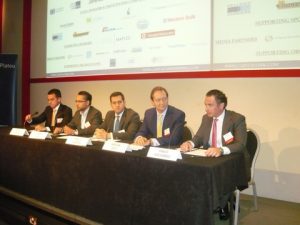
Alexis Atteslis, Akbar Rafiq, Paulo Almeida, Andrian Dacy with moderator Panos Katsambas
The warm up of the forum is by now complete and on time the Role and Significance of Private Equity panel discussion took its place on… the dock… Headed by our known Panos Katsambas, partner at Reedsmith’s the panel comprised of Andrian Dacy, managing director, global head of maritime global real assets group at JP Morgan Asset Management; Paulo Almeida, portfolio manager at Tufton Oceanic; Akbar Rafiq, co-head of European credit at York Capital Management and the up and coming Alexis Atteslis, principal at Oak Hill Advisors (Europe) LLP
Issues touched and expertly explained: “Cycle has been slower than original anticipated in the growth of PE funds in this space. Turnarounds have taken longer and exits have taken longer too. You are now seeing more assets come to the market”
“Consolidation of companies is a good thing and you’re seeing this now.”
“Shipping’s risks and rewards need to be looked at vs. other real assets like real estate, timberland or infrastructure. Additional risk requires higher reward as it is unpredictable and you need to be very nimble. There are a few PE players that got into shipping without their eyes open and got hurt badly as they underestimated the risks and overestimated expected returns.”
“What qualities would an institutional investor seek from a shipping investment? A good-quality partner is critical as the sector is too complex and there are many unknowns in each deal.”
“What types of PE deals are interesting in the market today? More of a consolidation theme, as a lot of capital was put in play over the last few years and people are now looking for ways to add more value and consider exits. PE is looking less at new builds and within gas, they’re looking at more project-related deals. Activity overall will be smaller in the coming year or two.”
“LNG is likely to go through a tough patch over the next few years but other areas look interesting in terms of sectors. Having said that, we need to see earnings at healthier levels before we see long-only investors coming to the shipping space and support more IPOs. Expect more consolidation to continue in the coming years.”
“PE reliance on leverage and impact of declining liquidity in the US/ potential increase in Europe – shipping tends to be a space where there is little or often no leverage used in deals.” And lastly the “Sustainability of deals is key in successful deals.”
Questions on sustainability and the percentage of private as well the availability of private equity, come naturally from the audience…
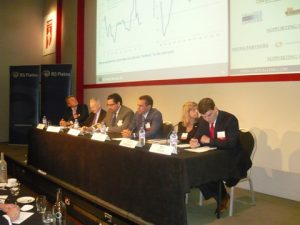
Jens Ismar, Hamish Norton, Emanuele Lauro, John Dragnis, Fotini Karamanlis and moderator Ben Nolan
The Dry Bulk sector Update – the most awaited by the audience panel discussion, was indeed on time, thanks to the efforts of the organisers and the time-conformity of all panellists until this very moment. There was a sector review by Frode Morkedal a shipping analyst from RS Platou Markets AS and Ben Nolan from Stifel Financial Corporation moderated the five-member strong panel where we had for the first time a woman, Fotini Karamanlis, CEO from Hellenic Carriers Ltd, An AIM company; John Dragnis, CEO Goldenport Holdings – two Greeks ever present in this panel and Capital Link events; Emanuele Lauro, chairman & CEO from Scorpio Bulkers, the ever present and well known Hamish Norton, president of Star Bulk Carriers and Jens Ismar, CEO from Western Bulk.
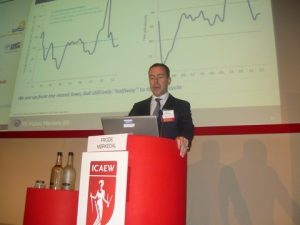
Frode Morkedal delivering his overview on the dry bulk sector
Herebelow is what we’ve heard:
“We are up from the recent lows but only halfway to normalised market levels.”
“Annual fleet growth expected at 5-6%, having come down from recent years. However, the market stalled in 2Q14 and demand growth is only 5%. Will demand rebound or is there a trend change happening? China obviously has a lot to do with this.” Mentioning China my mind went back one and a half week ago when on the 11th of September at the IMIF buffet luncheon at Lloyd’s Register, Mr. Shicheng Yang, Chief Executive, COSCO UK Limited gave us his thoughts on “Can we still rely on China?”…
“Iron ore imports in China have risen helped by low iron ore prices but the coal imports have fallen by 5% year-to-date and continues to deteriorate month-on-month. Indonesian export ban (minor metals) is also contributing to lower volumes.
- No growth in Chinese domestic steel consumption. With GDP at 7% you would have expected something more.
- China restricts coal imports with high-ash, high-sulphur. If China reduces coal imports there will be no recovery for bulk commodities
Downside risks have increased – take profit if you believe China’s coal ban is real.
The short term view is that we will see a strong Q4 with iron ore exports from Brazil and India coal imports helping the picture. However, as the price of steels have come back, there’s less demand from the mills and inventories are high – this may mean that the Q4 recovery might not come through.”
Fotini Karamanlis – “if you combine iron ore imports increases and increased coal shipments ahead of winter and grain shipping in the Gulf, the outlook looks good for Q4. Further ahead, Chinese coal demand has been weakening but Indian coal demand has been strengthening. Volatility will persist and it’s naive to think recovery will come in a straight line. It’s all about your getting your timing right.”
John Dragnis – “seeing more movement in the Atlantic cargo market with good rates. Coal into India is seeing good volumes as well. Positive for Q4 (although not stronger than Q4 2013) and 2014 being better than 2013.”
Emanuele Lauro – “Company launched in 2013 and has one ship in the water and 79 being ordered to be received in 2015/16. High quality assets, balance sheet in check and low leverage are key to survive this market.” A very outspoken panellist!
Hamish Norton – “103 dry bulk ships (34 in delivery). Expect 2015 to be a little better than 2014. Iron ore prices being so low have squeezed out the Chinese producers. Low coal prices have pushed a few of the overseas coal producers below cost when you include the shipping. They expect this situation to correct though in the future.”
Jens Ismar – “Being an asset-light company, they have flexibility to play the volatility in this market. We are moving into a much more challenging environment. Optimism in 2013 was misplaced and the high order numbers will plague the market for the coming few years.”
“Iron ore – long term fundamentals have not changed but it is a difficult commodity to read. It’s better for a shipping company to focus on the things they can control (like the quality of its assets and the health of its balance sheet) than worry about iron ore expectations.”
On the crucial question by Ben Nolan: “What would you do with US$100m?”, these are briefly the replies:
FK: Panamaxes, handys in the second hand market and stagger the investment
JD: See how the market is going but don’t invest in new buildings. Decent assets out there on the second hand that could make good money.
EL: Japanese capes
HN: Japanese capes
JI: Keep money in the bank and wait for a PE guy to come in with a good deal”
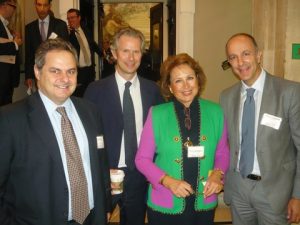
Takis N. Pappas and Henrik Piper form Silvestream technologies with Olga Bornozis and Stamos Birsim form Olyvon at the lunch break
Food for thought gave its place to real food and soft drinks at the mezzanine hall where an excellent light buffet was awaiting us, and as the delegates increased, we were spread all over the ICAEW (Institute of Chartered Accountants for England and Wales), space; a very historic building for those interested in architecture and tradition. Remind you the ICAEW is a world leader of accountancy and finance profession! Networking at its best and the only time to meet with old friends from all over the world!
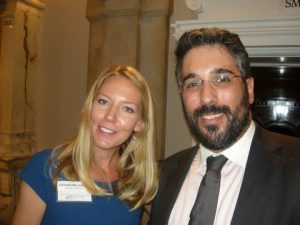
Georgina Gavin from VesselsValue with Nicholas M. Petrakakos of Z Capital Partners

Argyrios Emmanouilidis from Deloitte and Alexia N. Inglessis from Samos Steamship Co.
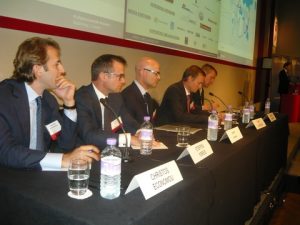
Christos G. Economou, Steffen Foreid, Stuart Buchan, Tony Lauritzen and moderator Douglas Mavrinac
Back to the ICAEW’s auditorium for the LNG sector, the upcoming energy/sector of the shipping industry; the LNG sector overview was delivered by Christopher Bergsland, partner at the RS Platou Energy LLP. Douglas Mavrinac , managing director, head of Maritime Equity Research group at Jefferies was the panel’s moderator. Panellists included Tony Lauritzen, CEO from Dynagas Ltd; Stuart Buchan from Golar; Steffen Foreid, CEO at Hoeg LNG and Christos Economou, founder TMS Cardiff Gas Ltd.
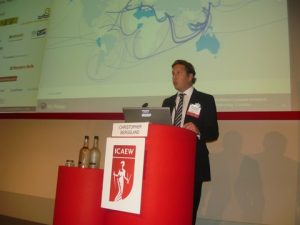
Christopher Bergsland presenting the LNG sector’s overview
Points noted, where:
“ There is a 60 centum increase on the LNG”
“The difference on the LNG is that ships move whilst pipelines don’t; a more secure modus operandi”
“Speculative orders are coming now in the market”
“You’ve got vessels of more 30, 000 m3 of LNG on size, that’s more revenue!”
“There is a third wave of speculative orders are there and the 10 to 15, 000 m3 size goes for the 170/180, 000 m3”
“Floating liquefaction”
“Ordering of tonnage is a result of foolishness”
“A very promising sector” and “…a very optimistic market projection”
“Different Locations” and “Technical a simple solutions to clean” on the LNG’s
“West Africa, Gulf of Mexico, US, Canada and Australia the places to watch”
One question from the audience addressed to Tony Lauritzen on “What opportunities do you see?” received a simple reply: “Go with the customers”
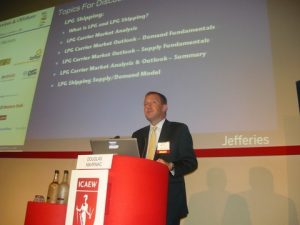
Douglas Mavrinac presenting the LPG sector at the podium
LPG Shipping Panel Discussion, a 50 minutes exceptional session come up with a sector overview delivery by Douglas Mavrinac, managing director, head of maritime equity research group from Jefferies LLC, who was also the panel’s moderator. Panellists included Christian Andersen, president of Avance Gas, John Lycouris Dorian LPG’s CEO and Lars Vang Christiansen, CEO from Epic Gas.
Here are the main points discussed: “LPG includes propane, butane, butadiene, isipropane, propylene and vinyl chloride monomer among others.”

l to r: Lars Vang Christiansen, John Lycouris, Christian Andersen and Douglas Mavrinac
“LPG charter rates at very profitable levels entering 2014
Majority of LPG destined for Asian developing economies
Majority of LPG supply has been from the Middle East – the US market is a gamechanger, as US export capacity is growing materially.
LPG trade projected to grow 9% in 2014 and 13.3% in 2015.”
“You don’t have the same red tape to export LPG as you do with LNG – you simply need an export terminal.”
Projects by: Targa, Energy Transfer Partners, Occidental Petroleum, Marcus Hook , Enterprise, Philips 66.
LPG shipping demand growth is robust and expected to strengthen further. it is expected to exceed supply growth in 2014 and match supply growth in 2015.
Avance Gas – making a lot money from their 6 ships and will be returning excess cash to shareholders. Glad there is a lot of LNG shipping supply because this helps the dynamics for LPG.
Dorian LPG – four ships in the water and 16 coming by 2016. Look to take advantage of spot pricing. They will look at dividends and MLPs in the future
Epic Gas – 47 ships. Don’t outsource any part of their business.
Strong belief in ethane trading but this is very early days; very few exporting terminals in the US and hardly and receiving terminals in the world. This is something that will grow like LNG has in the next 5 years.”
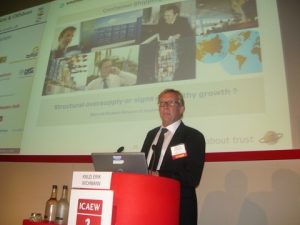
Knud Erik Wichmann delivering his slides supported presentation
The Container Shipping Market update was a solo presentation by Knud Erik Wichmann, head of research at Maersk Broker:
“Global trade is growing, following 7 bad years. The key demand drivers have been the following:
- Asian economies move from investment driven to consumption driven and intra-Asia trade grows
- US economy is recovering
- Trade growth projections suggest increased demand for Container transport and capacity
Key factor for the container market is continuing to reduce the costs
Main trends:
- Financial pressures on shipping lines, owners, banks etc. are negatively impacting sentiments and decisions in the market
- From capacity driven to performance driven thinking – focus on OPEX and efficiency
- deployment of very large container-ships to keep down costs
- expansion of shipping-line alliances – Economies of scale
- new vessel designs – ECO, WB to reduce bunker cost and slot cost
- Feeder vessel segments: oldest fleet and thin order segments of opportunity
Utilisation is expected to increase and the charter rates will likely follow through.
Several variables indicating a bottom has been reached and that recovery will start after the next couple of years. From 2016 – 2018, they expect demand growth to outstrip supply growth.”
Being a field that has lately dominated the market with mergers, consolidation et al I did questioned the risks of say a Suez Canal closing and the effects of such a situation, as well as the “fight” between liner and individual owners of containerships! The speaker indeed liked the question and a discussion took place… even after his delivery.
One thing to remember from this session, is the… catch phrase following a question on “how the container trade market develops” that “the container trade has been called the mother of Globalization”. There is also in-sourcing and not out-sourcing”. Interestingly we heard also that the message in the container trade is “A total reduction of the slot cost”. The big alliances also dominated his slides and discussion. “From high speed in the 70’s to slow steaming now…” Excellent!
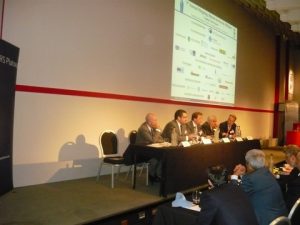
George Saroglou, Emanuele Lauro, Svein M. Harfjeld, Marco Fiori and moderator / sector reviewer Herman Holdan
The view on the Tanker markets was an over an hour panel. The overview was performed by Herman Hildan, shipping analyst at the RS Platou Markets AS, who was also the panel’s moderator. Panellist included: our familiar on Capital Link’s and other conferences Marco Fiori, CEO of d’Amico International Shipping; Svein M. Harfjeld, co-CEO of DHT Holdings Inc, once again the ever diverse Emanuel Lauro, Chairman & CEO of Scorpio Tankers and lastly one familiar speaker and panellist: George Saroglou, COO from Tsakos Energy Navigation Ltd.
Points from this panel: “Some say that the US shale revolution killed the tanker market – but this is wrong.”
“In 2007, the US imported over 2m bpd from Nigeria, Angola and Algeria – they now import only 0.2bpd. As West African markets now export further afield, the transportation distances for tankers are also increasing.”
“The tanker market crashed not for lack of demand but excess tanker supply.”
“Low supply growth, weak trade but higher distances.”
Individually we’ve heard:
d’Amico Shipping – only product tankers and a young fleet. They are not big spot players but instead then to be opportunistic with time charters.
DHT – 14 vessels and 6 being built. $24k per day is breakeven level. Expect moderate demand growth and supply growth close to 0% over the next 3 years.
TEN – a 5.5 years old fleet!
Yards are operating at 50-60% capacity as the offshore demand has gone away but prices have not really come down.”
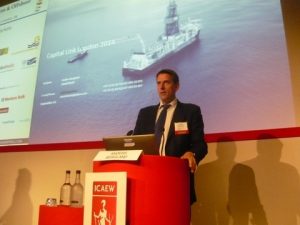
Anders Bergland overviewing the sector
The Offshore Drilling & Offshore Supply Sectors were reviewed by Anders Bergland, the head of equity research at the RS Platou Markets AS. The duties of the panel moderator where undertaken by Truls Troan, head of corporate finance at the RS Platou Markets AS. Panellists were: Finn Amund Norbye, CEO Deep Sea Supply; Njal Saevik, CEO of Havila Shipping ASA; Ragnvald Kavli, CFO from North Atlantic Drilling Ltd and Bjornar Iversen, CEO at Songa offshore.
Major points to remember here are “the 140 newbuildings and the fact that the floater supply exceeds demand”
“There is a 4 centum growth, but there is a mismatch of demand and supply on OSV’s”
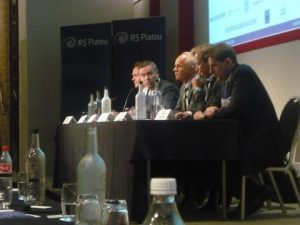
Bjornar Iversen, Ragnvald Kavli, Njal Saevik, Finn Amund Norbye and Truls Troan
“The sanction re sanctions”
“The Unions issues”
“Carleen Lyden-Kluss landed a double question from the environmental perspective and exploration on Cyprus”
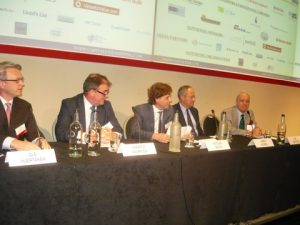
Ole Hjertaker, Andrew Hsmpson, Nicolas Busch, James Kidwell and moderator Clay Maitland
The last panel being that on Investment & Business Opportunities in Shipping today and the discussion that followed was fairly interesting; Chaired by the iconic Clay Maitland, managing partner at the International Registries Inc., had the following as panellists: James Kidwell, CEO from Braemar Shipping Services plc; Andrew Hampson, managing director, asset backed investments from Tufton Oceanic Ltd, and Ole Hjertaker, the CEO from Ship Finance International.
Herebelow is what was discussed:
Clay Maitland – do optimists make better investors in this market?
James Kidwell – No, you have to be a realist and a long term investor with a 20+ year investment horizon.
Andrew Hampson – You have to analyse the fundamentals and ensure your downside assessment is spot on
Ole Hjertaker – We haven’t seen sustainable returns – the people that make the most money in this space are the brokers and the bankers.
You see more volatility in the tanker and dry bulk market, so you need to be more careful – the container market offers more reliable yields.
Tufton – dry bulk and gas sectors have the best opportunities in their view.
Do you look at technology and the influence on the industry?
There is not enough money spent on either market or technology research by shipping companies but change is gradually coming through necessity. Look at fuel efficiency improvements in cars vs. ships. Regulation is also gradually changing the landscape.
The arrival of ecoships also has the potential to disrupt market dynamics – this is already happening with container ships; 10yrs ago, the average age of a ship going for scrap was 30 years, while now it is 21 yrs.
Do you see any major factor that is increasing the cost of operating or building a ship in recent years?
We are seeing a divergence in rates within the shipping industry as sectors react to short-term factors (e.g. LPG).
The US is going through a transformation akin to that which China went through in terms of impact, as far as energy pricing is concerned.
Yards depend on new orders in order to finance themselves. Given the fact that the order books are full to 2017, it’s unlikely you’ll see bargain prices for some time to come.
Counterparty risk and residual value risk are two of the major risks in this industry.
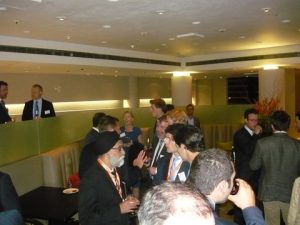
A view from the Cocktail Reception where networking was at the fore, sponsored by Holman Fenwick Willan
The reception that followed at the basement gratis Holman Fenwick and Willan, gave us the opportunity to enjoy the plentiful dips and drinks but also to network with those each one of us wanted all day long; and it was indeed more than one can anticipate!
Ending this report we do wish to mention the support of the Global Lead Sponsors: ABN AMRO and TEN Ltd; The Global Gold Sponsors: DVB Bank and Goldenport Holdings Inc; The Global Sponsors: Clarkson, Hollman Fenwick Willan, Jefferies, Norton Rose Fulbright, Reedsmith, The Marshall Islands Registry; The Event Sponsors and Participating Companies: Charles Stanley, d’Amico, Dorian LPG, Dynagas LNG Partners LP, Hellenic Carriers, Ridgebury, Star Bulk Carriers Corp, Tufton Oceanic, Westren Blk. The Supportive sponsors: Maples and VesselsValue.com; the media Partners: Thompson Reuters, BraclayHedge, Lloyd’s List, The Maritime Executive, Ship2Shore, Tradewinds, World Oils, AllAboutShipping.co.uk. Finally the supportive organisations: IMarEST, Maritime London and SPNL.
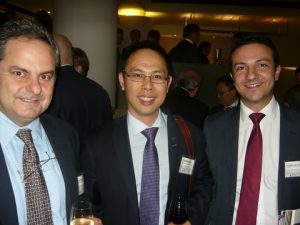
Takis N. Pappas from Silverstream Technologies, with Edwin Pang from Knud E. Hansen A/S in London and Evangelos Assimakos, Investment Manager at Rathbones in Edinburgh
We look forward in seeing most of you in Athens on the 8th of October for the Maria Tsakos Foundation event at the Evgenideion Foundation, then at the New York Dissect ETFs Forum on the 23rd of October and on the 4th of November here in London for the 4th Capital Link Events on the CSR!
Congrats to Nicolas and Olga Bornozis as well as their international events team for their professional performance.
